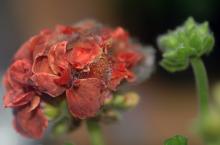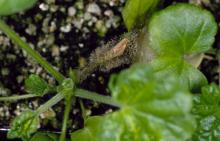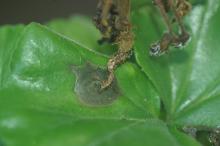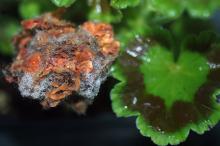See:
Greenhouse Plants, Ornamental - Gray Mold
Cause Botrytis cinerea, a fungus. All aboveground parts of seedlings and mature plants are susceptible. Spores are readily spread by air and the fungus can infect intact or wounded tissues. The disease is most prevalent in cool, moist greenhouses where plants are irrigated frequently. High relative humidity, moisture on the plant, and temperatures between 64°F and 77°F favor infection. Any activity in the greenhouse that changes the relative humidity quickly or disturbs the pants can result in the release of spores. Flower susceptibility increases with age, the lowest point being when they first open. Stock plants can be an important source of infection. Lower leaves of cuttings may yellow, abscise, and harbor the fungus, leading to losses during propagation.
Symptoms Brown, water-soaked areas appear on leaves and petals. Spots dry out and are covered by brown masses of fungus growth. Flowers wilt and drop. Brown zonate leaf lesions often result after petals drop on leaves. Stock plants may develop a stem blight, which can progress down the main stem. "Ghost spots" can also occur if a lesion has been arrested.
Cultural control An integrated strategy combing environmental management, cultural practices, and fungicides will most effectively manage this disease.
- Thoroughly clean and sanitize the greenhouse before production.
- Remove and destroy leaves showing infection and any fading flowers. Place into a closed container for removal from the greenhouse.
- Do not hang plants above that would tend to drop faded flowers onto geraniums.
- Increase spacing between plants.
- Water at base of plants and/or with drip irrigation. Do not wet foliage.
- Reduce humidity by increasing temperature and improving ventilation. Particularly important for stock plants the first 24 hours after taking cuttings. Heating the greenhouse at night (especially for zero or negative DIF) or venting around sunset may be necessary. Heating in the morning before sunup can also help prevent dew formation as air temperature increases faster than the temperature of plant parts. If using DROP or DIP for size control, do not let humidity rise above 90%.
- Forcing dry air for 2 days on cut geranium stock plants, beginning within hours of cutting, significantly reduced gray mold. Avoid leaving large stubs on stock plants after cutting.
- The use of calcium chloride on stock plants prior to taking cuttings has been helpful.
- The use of ethylene blockers (such as EthylBloc) before shipping may be helpful.
- Ensure cuttings are transported to final destination within 2 days.
Chemical control Use as foliar sprays in conjunction with cultural control methods. Preventative applications are better than curative applications. Resistance can become a problem with repeated use of a single product. Tank-mix or rotate materials from different groups with different modes of action. Limit the use of any one group during the growing season.
- Affirm WDG at 0.25 to 0.5 lb/100 gal water. Group 19 fungicide. 4-hr reentry.
- Astun at 10 to 17 fl oz/100 gal water. Group 7 fungicide. 12-hr reentry.
- Bonide Fung-onil Multi-purpose Fungicide at 2.25 teaspoons/gal water. Group M5 fungicide. H
- Broadform at 4 to 8 fl oz/100 gal water. Group 7 + 11 fungicide. 12-hr reentry.
- Chipco 26019 FLO at 1 to 2.5 quarts/100 gal water. Group 2 fungicide. 12-hr reentry.
- Daconil Weather Stik at 1.38 pints/100 gal water. Group M5 fungicide. 12-hr reentry.
- Decree 50 WDG at 0.75 to 1.5 lb/100 gal water. Group 17 fungicide. 12-hr reentry.
- KleenGrow at 6 to 38 fl oz/100 gal water. 48-hr reentry.
- Mancozeb-based products can be used as mixing partners and provide some protection. Group M3 fungicides. 24-hr reentry.
- Fore 80 WP at 1.5 lb/100 gal water plus a spreader-sticker.
- Protect DF at 1 to 2 lb/100 gal water plus 2 to 4 oz spreader-sticker.
- Medallion WDG at 2 to 4 oz/100 gal water. Use with oils or adjuvants may damage plant. Some geranium cultivars may become stunted or chlorotic when higher rates are used. Group 12 fungicide. 12-hr reentry.
- Mural at 4 to 7 oz/100 gal water. Group 7 + 11 fungicide. 12-hr reentry.
- Nu-Cop 50 DF at 1 lb/100 gal water. Group M1 fungicide. 48-hr reentry. O
- OHP 6672 4.5 F at 10 to 14.5 fl oz/100 gal water plus another fungicide. Group 1 fungicide. 12-hr reentry.
- Orkestra at 8 fl oz/100 gal water. Group 7 + 11 fungicide. 12-hr reentry.
- Pageant at 12 to 18 oz/100 gal water. Do not use with organosilicone-based adjuvants. Group 7 + 11 fungicide. 12-hr reentry.
- Phyton 27 at 1.5 to 2 oz/10 gal water. Registered but may not work well. Group M1 fungicide. 48-hr reentry.
- Postiva at 10 to 28 fl oz/100 gal water. Group 3 + 7 fungicide. 12-hr reentry.
- Sil-Matrix at 1 to 4 quarts/100 gal water plus a nonionic surfactant. Do not use on open blooms. 4-hr reentry. O
- Spectro 90 WDG at 1 to 2 lb/100 gal water. Group 1 + M5 fungicide. 12-hr reentry.
- Terraguard SC at 4 to 8 fl oz/100 gal water. Group 3 fungicide. 12-hr reentry.
- Trinity TR at 1 can/3,000 sq ft of greenhouse. Poor control. Group 3 fungicide. 12-hr reentry without ventilation or 4-hr with ventilation.
Some registered products offer only suppression of this disease and thus are not recommended for use. These products include Heritage.
Biological control
- AmyloShield (Bacillus amyloliquefaciens strain PTA-4838) at 1.5 to 3.5 lb/A outdoor or 0.6 to 1.2 oz/gal in the greenhouse. Unknown efficacy. Group BM02 fungicide. 12-hr reentry. O
- Cease or Rhapsody (Bacillus subtilis strain QST 713) at 2 to 8 quarts/100 gal water. Active ingredient is a small protein. 4-hr reentry. O
- LALStop G46 WG (Clonostachys rosea [formerly Gliocladium catenulatum] strain J1446) at 0.13 oz/1 gal water. Do not use with other products in the tank. 4-hr reentry. O
Note The use of compost teas is not recommended due to high variation in product efficacy.
Reference Scheuerell, S.J. and Mahaffee, W.F. 2006. Variability associated with suppression of gray mold (Botrytis cinerea) on geranium by foliar applications of nonaerated and aerated compost teas. Plant Disease 90:1201-1208.





